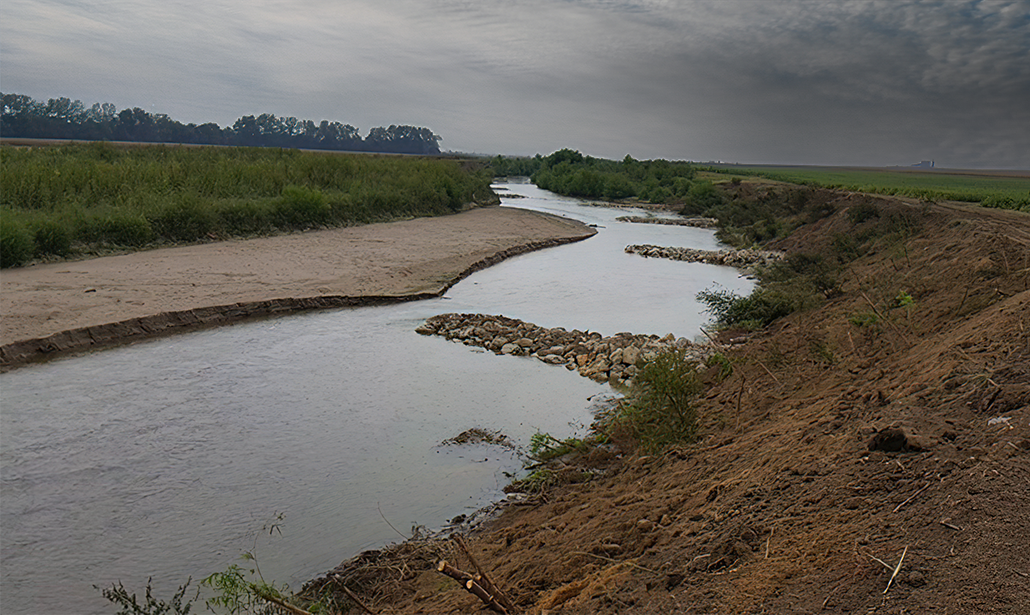
Welcome to CivilGEO Knowledge Base
Welcome to CivilGEO Knowledge Base

Welcome to CivilGEO Knowledge Base
Welcome to CivilGEO Knowledge Base
The River Channel Modification command allows the user to define a trapezoidal cut into the existing channel geometry or create a new channel geometry. In order to perform a channel modification analysis, a hydraulic model of the existing river reach is required. Once the model is complete, channel modifications can be made to perform trapezoidal cuts and fill into the existing geometry. The user can see a profile view of the channel modification along the river, and can either draw the channel bottom, define a channel bottom slope to use, or instruct the software to interpolate the channel bottom between selected cross sections. In addition, the user can specify that the channel modification follow along the existing river centerline or select a new alignment polyline to use—for example, when performing stream channel restoration back to a sinuous river path.

After the changes have been added to the river channel, a HEC-RAS analysis can be performed to see what effect these changes have on the computed water surface elevation, depth of flow, velocity, and shear stress. This command can be used when performing stable channel design and for fish waterway and passage design.
Follow the steps below to use the River Channel Modification command:


The following sections describe how to interact with the above dialog box.
This section is used to define the river and the reach for performing channel modifications. Follow these steps:


Alternatively, click on the [Pick] button and the River Channel Modification dialog box will temporarily disappear. The software will then prompt the user to select the river reach from the Map View. After selecting a river reach, the River Channel Modification dialog box will redisplay with the river reach shown as selected.
In addition, a graphical plotting is provided that displays a longitudinal view of the river reach and the modified river reach.
This section allows parameters to be defined for performing channel modifications and for creating a new channel template. This includes the modification method and respective parameters for defining channel inverts over a range of cross sections as well as the parameters to define a trapezoidal cut for the selected cross sections. The following optional tabs are available:








This section contains a table that displays a summary of all modifications that will be made to the selected river reach when the new geometry is created. Any update in the modification data is automatically reflected in the table.
This section allows for rapid enter/edit of the channel modification data in the modification summary table (described above).
Follow the steps below to update the channel modification data:

By default, the channel modifications are applied based on the existing river centerline. However, this section allows the user to interactively select a new alignment polyline to use for channel modification. This option is useful when performing stream channel restoration back to a sinuous, pre-channelized path. Click on the [Pick] button adjacent to the Select channel center polyline entry and select the new alignment polyline from the Map View.

After the options for channel modification have been defined, click the [Apply] button, and the software will create a new modified channel geometry.
 1-800-301-02-955
1-800-301-02-955
 608-729-5100
608-729-5100
(US and Canada)
 [email protected]
[email protected]
 +1 608-729-5100
+1 608-729-5100
CivilGEO India
Graphix Tower, A-13 A
3rd Floor, Sector 62
Noida, Uttar Pradesh 201309
IndiaTel:
1-800-301-02-955 or
+91 022-3831-8601
CivilGEO United States
8383 Greenway Blvd
6th Floor
Middleton, WI 53562
USATel:
608-729-5100 or
800-488-4110
Copyright © CivilGEO, Inc. All rights reserved. The CivilGEO logo, “GeoHECHMS”, “GeoHECRAS”, and “Ready To Engineer” are registered trademarks of CivilGEO,
Inc. All other brands, company names, product names or trademarks belong to their respective holders.
We use cookies to give you the best online experience. By agreeing you accept the use of cookies in accordance with our cookie policy.
When you visit any web site, it may store or retrieve information on your browser, mostly in the form of cookies. Control your personal Cookie Services here.
The ZoomInfo WebSights snippet drops three cookies to track Unique Visits:
1. _pxhd - Related to the Perimeter X security layer (Perimeter X isused to prevent bot attacks).
2. _cfduid - Related to the CloudFlare security layer (CloudFlare is the Network Security protocol that ZoomInfo uses to orchestrate the rate limiting rules).
3. visitorId - This is how WebSights identifies recurring visitors








